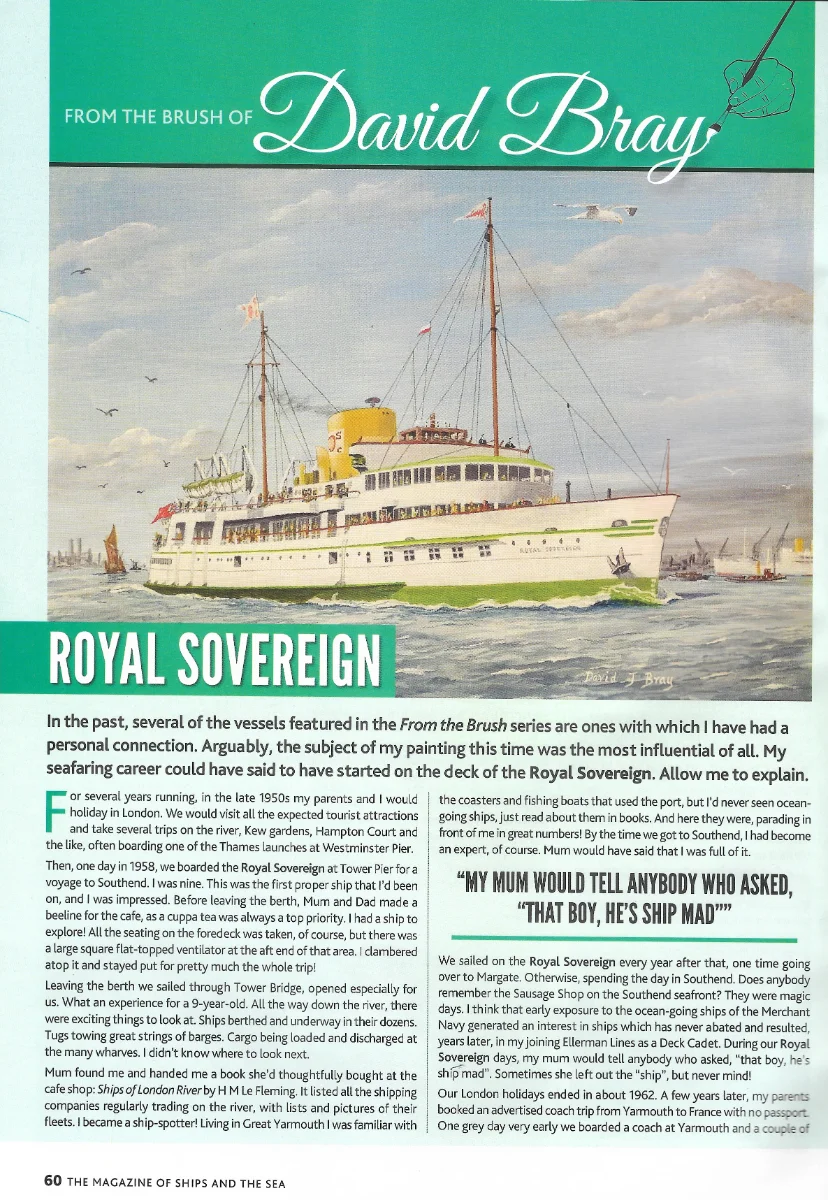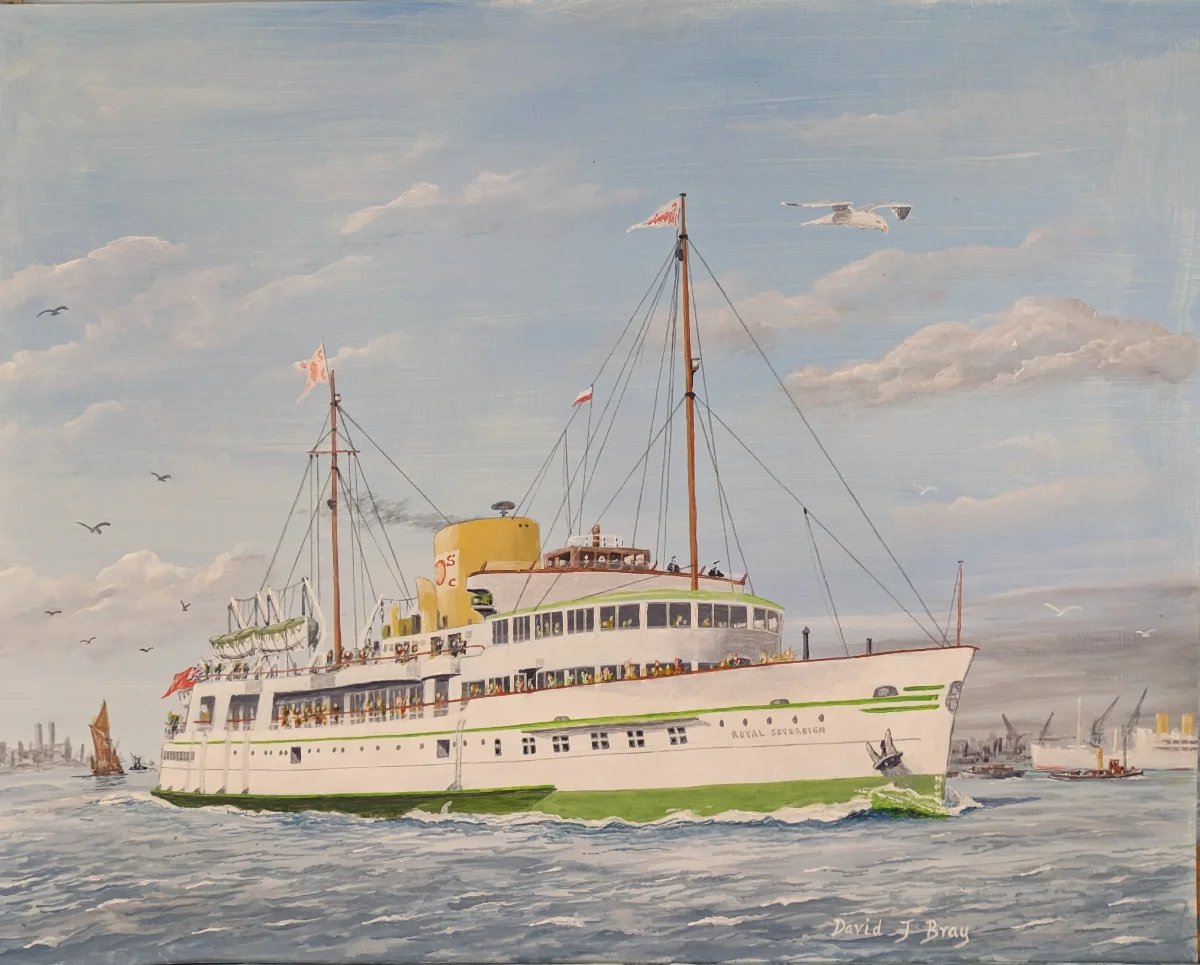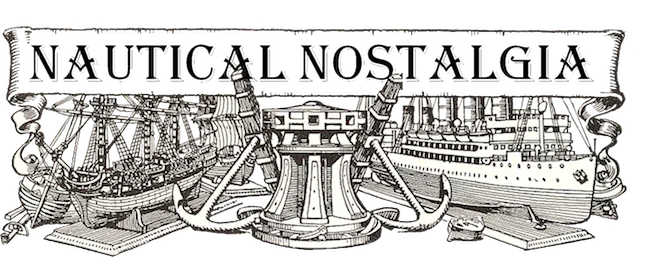From the brush of David Bray


In the past, several of the vessels featured in the “From the brush” series are ones with which I have had a personal connection. Arguably, the subject of my painting this time was the most influential of all. My seafaring career could have said to have started on the deck of the “Royal Sovereign”. Allow me to explain.
For several years running, in the late 1950s my parents and I would holiday in London. We would visit all the expected tourist attractions and take several trips on the river; Kew gardens, Hampton Court and the like, often boarding one of the Thames launches at Westminster pier.
Then one day in 1958 we boarded the “Royal Sovereign” at Tower pier for a voyage to Southend. I was nine. This was the first “proper ship” that I’d been on, and I was impressed. Before leaving the berth mum and dad made a beeline for the cafe as a cuppa tea was always top priority. I had a ship to explore! All the seating on the foredeck was taken, of course, but there was a large square flat-topped ventilator at the aft end of that area. I clambered atop it and stayed put for pretty much the whole trip!
Leaving the berth we sailed through Tower Bridge, opened especially for us. What an experience for a 9 year-old. All the way down the river there were exciting things to look at. Ships berthed and underway in their dozens. Tugs towing great strings of barges. Cargo being loaded and discharged at the many wharves. I didn’t know where to look next.
Mum found me, and handed me a book she’d thoughtfully bought at the cafe shop; “Ships of London River” by H M Le Fleming. It listed all the shipping companies regularly trading on the river, with list and pictures of their fleets. I became a ship-spotter! Living in Great Yarmouth I was familiar with the coasters and fishing boats that used the port, but I’d never seen ocean-going ships, just read about them in books. And here they were parading in front of me in great numbers! By the time we got to Southend I had become an expert, of course. Mum would have said that I was “full of it”.
We sailed on the “Royal Sovereign” every year after that, one time going over to Margate. Otherwise spending the day in Southend. Does anybody remember the “Sausage Shop” on Southend sea front? They were magic days. And I think that early exposure to the ocean-going ships of the Merchant Navy generated an interest in ships which has never abated, and resulted, years later, in me joining Ellerman Lines as Deck Cadet. During our “Royal Sovereign” days, my mum would tell anybody who asked.. “that boy he’s ship mad”. Sometimes she left out the “ship” but never mind!
Our London holidays ended in about 1962. A few years later my parents booked an advertised coach trip “Yarmouth to France no passport”. One grey day very early we boarded a coach at Yarmouth and a couple of hours later arrived at Clacton pier. I was thrilled to see the “Royal Sovereign” berthed at the end of the pier, waiting to take us to Calais. We had a fabulous trip, including a coach trip along the French coast. But the best bit was to come. Returning to the ship for the voyage home, the wind had piped up and was now about force 9. It was a very rough trip back across the channel, but I was in my element! But most disappointed to find the fish-and-chip shop closed as they couldn’t keep the fat in the pan! Neither my folks nor I were seasick but many were. It was too lumpy for the vessel to go alongside Clacton pier, so the ship continued round to Harwich, berthing at Parkeston Quay, where our coach was waiting for us. My first deep-sea foreign-going voyage, remembered forever.
The “Royal Sovereign” was pretty much the last in the line of coastal pleasure steamers. These vessels were an institution; for about 100 years paddle steamers and later, motorships, took thousands of city-dwellers on day trips, or to holiday destinations. A London fami!y could board the Belle steamer at Tower pier, and disembark at Felixstowe, Southwold or Great Yarmouth for their annual seaside holiday. Similar services were operated on the South coast, the Bristol channel and the Clyde. The advent of the motor car rendered these services non-viable, and they had all but disappeared by 1960. In 1966 “Royal Sovereign” was based in Great Yarmouth, offering day trips to France, but the venture was not a success. Passenger numbers were disappointing, and the vessel was not suited to the river. She was too long to turn in the river Yare, so would have to sail downriver and out the entrance stern-first. Not easy in a vessel with no bow thruster, and that particularly intractable configuration; twin screw with a single rudder.
The shiphandling skills of the captains of these vessels were phenomenal. Imagine coming up the Thames on a spring flood tide, shooting Tower bridge, and then having to turn short round to starboard to go alongside Tower pier. Space very restricted, lots of other craft on the move, and London bridge just upriver. And usually dark. The master of “Royal Sovereign” during this period was Captain W Kelly, a well-respected shipmaster.
I noticed that this vessel was equipped with aft-facing navigation lights in addition to the normal array. These lights would be shown when navigating stern-first for any distance. Did they also have a bow rudder? And maybe it was common to negotiate Tower bridge stern-first on her return to the Pool. Maybe our readers can enlighten.
The “Royal Sovereign” was built in 1948 by Denny’s of Dumbarton as a replacement for the very similar ship of the same name which had been lost during WW2. This earlier vessel was also built by Denny’s, in 1937, and entered service with the General Steam Navigation company. The successor to the well-known “Eagle steamers” fleet of paddlers, she operated on the London/Southend/Calais/Boulogne routes until the outbreak of war. Initially serving to transport young evacuees from London to the East coast ports, she was later taken up by the Admiralty as a troop transport, and renamed HMS “Royal Scot”. As a naval vessel, she could not keep her name, as there was a battleship called “Royal Sovereign”. Participating in the evacuation of troops from Dunkirk, she was later torpedoed and sunk in the Bristol channel in December 1940.
The “new” “Royal Sovereign” entered service in 1948 and spent much of her career on the London/Southend/Margate/Ramsgate daily service. This was very seasonal, and she, together with her running-mates “Royal Daffodil” and “Queen of the Channel” , was laid up during the winter months.
“Royal Sovereign” entered service in July 1948. She was powered by twin 12-cylinder Sulzer diesels of 2,250hp for a service speed of 20 knots. She was 285ft loa by 48ft beam. Of 1850 tons gross she was licensed to carry 1783 passengers.
In 1967 she was sold to Townshend and converted to carry lorries between Dover and Zeebrugge as a ro-ro vessel. She was renamed “Autocarrier”. In 1973 she was sold to the Italians for ferry services in the Mediterranean, renamed “Ischia”. Sailing mostly between Naples and the island of Ischia, she eventually went to the breakers at Aliaga in 2007.
I like to remember her in her glory days on the Thames, when the sun always shone and the water was blue, and the river was full of interest. That’s how I’ve painted her.
This article, and others, follow a series which Sea Breezes magazine is publishing, featuring David’s paintings, and the stories behind them.

2 comments
David Kinnear
Hi realty enjoyed your article on your Royal Sovereign trips 1 have a photo of my parents with friends on board what I think is the RS there is another photo of the same day ( all wearing the same clothes walking down Southend Pier!
Thanks and regards
David
Roy quinnear
I greatly enjoyed your post ,I too was a passenger and admirer of this vessel and enjoyed her in 1957 thanks for the reminder I am now 77 and living in Mexico